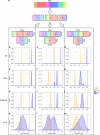A generalizable 29-mRNA neural-network classifier for acute bacterial and viral infections
- PMID: 32132525
- PMCID: PMC7055276
- DOI: 10.1038/s41467-020-14975-w
A generalizable 29-mRNA neural-network classifier for acute bacterial and viral infections
Abstract
Improved identification of bacterial and viral infections would reduce morbidity from sepsis, reduce antibiotic overuse, and lower healthcare costs. Here, we develop a generalizable host-gene-expression-based classifier for acute bacterial and viral infections. We use training data (N = 1069) from 18 retrospective transcriptomic studies. Using only 29 preselected host mRNAs, we train a neural-network classifier with a bacterial-vs-other area under the receiver-operating characteristic curve (AUROC) 0.92 (95% CI 0.90-0.93) and a viral-vs-other AUROC 0.92 (95% CI 0.90-0.93). We then apply this classifier, inflammatix-bacterial-viral-noninfected-version 1 (IMX-BVN-1), without retraining, to an independent cohort (N = 163). In this cohort, IMX-BVN-1 AUROCs are: bacterial-vs.-other 0.86 (95% CI 0.77-0.93), and viral-vs.-other 0.85 (95% CI 0.76-0.93). In patients enrolled within 36 h of hospital admission (N = 70), IMX-BVN-1 AUROCs are: bacterial-vs.-other 0.92 (95% CI 0.83-0.99), and viral-vs.-other 0.91 (95% CI 0.82-0.98). With further study, IMX-BVN-1 could provide a tool for assessing patients with suspected infection and sepsis at hospital admission.
Conflict of interest statement
M.M., L.B., R.L., U.M., J.W., D.R., M.R., K.C., and T.E.S. are employees of, and shareholders in, Inflammatix. P.K. is a shareholder in Inflammatix. The other authors have no conflicts of interest to declare. Certain machine learning architectures and normalization methods have been filed for patent protection by Inflammatix. The study, but not the Stanford ICU Biobank or the Stanford investigators, was funded by Inflammatix. AJR and the Stanford ICU Biobank are funded by NHLBI grant K23 HL125663.
Figures



References
-
- Torio, C. A., Andrews, R. A. National Inpatient Hospital Costs: The Most Expensive Conditions by Payer, 2011. HCUP Statistical Brief #160 (Agency for Healthcare Research and Quality, Rockville, MD, 2013). - PubMed
Publication types
MeSH terms
Substances
Grants and funding
LinkOut - more resources
Full Text Sources
Other Literature Sources
Medical

